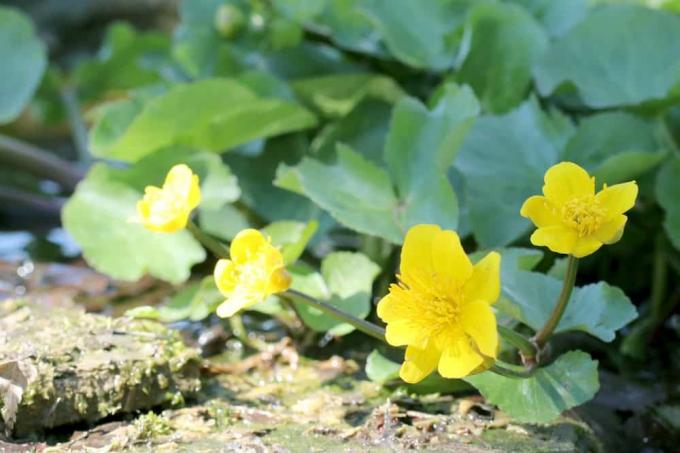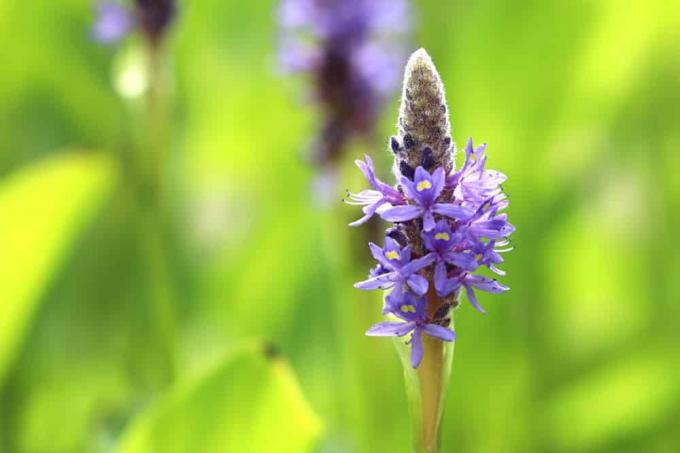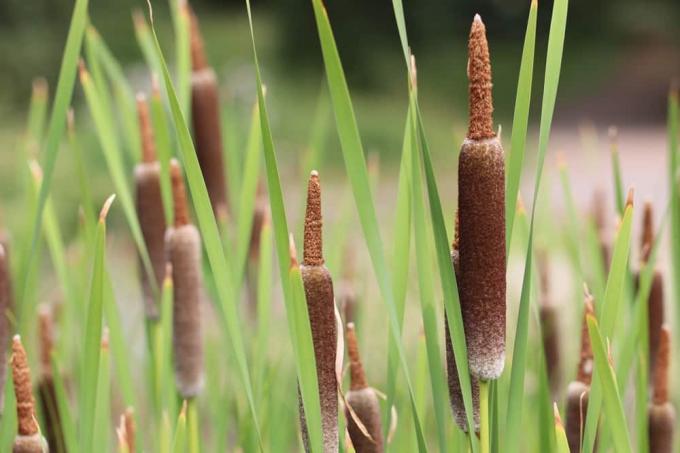

Table of contents
- Marsh marigold as a pond dweller
- location claims
- soil condition
- planting
- care instructions
- watering and fertilizing
- Cut
- hibernate
- multiply
- sowing
- division
- Diseases
- Rust fungus Puccinia calthae
- mildew
The plant, also known as cow, egg or milkweed, grows perennial and perennial. Depending on the location, it can reach heights of growth of 15 to 50 cm, but initially grows in width. As a result, it usually occurs in larger stocks. The intense golden yellow flowers, about four centimeters in size, appear from March. A second flowering is possible between July and October.
Marsh marigold as a pond dweller
The marigold from the buttercup family is a completely uncomplicated pond dweller that blooms on the banks of ponds, wet meadows or bog beds. It provides splashes of color visible from afar early in the year. It does not look particularly beautiful in groups of several plants. It can also be combined very well with other pond and bank plants of various plant species, for example with jester flower, marsh forget-me-not, water iris, false calla lily, bald cypress or cotton grass.
Its shiny, dark green and kidney-shaped leaves are also very decorative and rich in contrast. An aggregate fruit with up to eight so-called follicles develops from the withered flowers. They have the ability to swim, so that the marsh marigold can also spread on waterways.
Tip:
The cow flower is slightly poisonous in all parts of the plant and can cause skin and eye irritation on contact and in sensitive people. It is therefore advisable to wear gloves when handling this plant as a precaution.
location claims
The marsh marigold is best kept in standing or shallow waters such as the bank and shallow water area of a garden pond or stream.
- It thrives best when roots are in wet or moist substrate
- Preferably in a water depth of about five centimetres
- Develops best at this depth
- However, it should not be deeper than ten centimetres
- Cow flower likes to be in sunny to semi-shady places in the garden
- The upper parts of the shoot should always be above the water surface
- In dark locations with little light, formation of long, unsightly shoots
- The result is misshapen growth
- This significantly affects flowering
Tip:
If the soil is humus and, above all, moist enough, planting in the bed is also possible.
soil condition

As far as the soil is concerned, Caltha palustris prefers nutrient-rich, moist to swampy and heavy clay, loam or peat soil. While some varieties prefer slightly acidic substrates, others feel most comfortable on calcareous substrates. A pH value of 5.8 to 6.5 is recommended.
planting
Best planting time and soil preparation
The best time to plant marsh marigolds is in both autumn and spring. This presupposes that the water is not yet or no longer frozen and that no premature or delayed ground frosts are to be expected. Before planting begins, the planting area must be filled with a suitable substrate. You can enrich the existing soil with compost and, if necessary, mix it with clay or loam. Ultimately, the topsoil should have a thickness of at least 20 cm, because the marsh marigold is planted without it plant basket, it forms strong roots relatively quickly, which have to find a foothold in the ground in order not to be washed away become.
planting
If you want to plant in a pond with fish, it is generally advisable to put the plants in a suitable plant basket and then put them together with the basket in the pond or pond. to set the shallow water area.
- To do this, line the plant basket with some jute in advance
- Then fill with a suitable substrate or special pond soil
- Then plant the plant in the middle
- Fill with soil and weigh down with pebbles
- Now place the basket in the right place in the pond or on the bank
- If there is no shallow water area, raise the basket slightly
- For example, on a heap of stones or stacked stones
When planting both with and without a plant basket, ensure that the planting distances are sufficiently large. It is best to plant the cow flower in groups of 10-12 specimens each or small tuffs with 3-5 individual plants each. In between, planting distances of 25 to 30 cm should be maintained, because, as already mentioned, the cow flower initially grows in width.
care instructions
Caltha palustris is a very uncomplicated and easy-care plant that requires little care under optimal conditions. It tolerates even slight fluctuations in humidity without any problems. In order for the cow flower to thrive and bloom well over many years, a minimum of care is essential.
watering and fertilizing

If the plant is in the bank area or the shallow water zone of a pond, there is no need to water it. If, on the other hand, it is in a damp perennial bed, it must be watered regularly so that the soil is always moist. Fertilizer can also be dispensed with when planting in a pond. Fertilizer would do more harm than good here, because it could, among other things, encourage increased algae growth. Otherwise, the administration of an organic fertilizer is recommended, e.g. B. Horn shavings or bone meal, but only in moderation.
Cut
When cutting, the main concern is to prevent uncontrolled spread and, if necessary, to counteract an infestation with mildew or rust fungi. Immediately after the first flowering, cut off everything that is wilted and dead. This cut usually results in the cow flower starting a second bloom. In early spring, i.e. between January and February, the cow flower can also be cut back to just above the ground. Until then, the dead parts are left on the plant, as they serve as winter protection. It will then reliably sprout again in the spring.
hibernate
Hibernation is also not a problem, because the marsh marigold is hardy to about - 45 degrees. In the fall, it draws most of its plant parts above ground, only the root ball overwinters in the ground. As a result, no winter protection measures are necessary. Care should be taken when removing the dead parts of the plant in spring, as the marigold has already created new buds by this time.
multiply
The marsh marigold can reproduce very well in a natural way, namely via seeds. In addition, they can also be propagated manually by sowing seeds, but also via stolons or by dividing the rhizome. The double varieties are an exception, they are sterile and can therefore only be propagated by division.
sowing

To get seeds, wait until the flowers have withered, because then the follicles with the up to 2.5 cm long, brown seeds form. Once these pods have dried up, they burst open when they come into contact with water, releasing the seeds.
- Direct sowing is generally possible in summer or autumn
- Marsh marigold seeds belong to the cold and light germs
- Can only germinate for a very short time
- Especially when sowing in summer, cold treatment of the seeds is necessary
- Cold treatment is intended to remove germ inhibition
- To do this, first fill a waterproof bowl with nutritious pond soil
- Scatter the seeds on the ground
- Cover the seed very thinly with soil and press down lightly
- Then fill the bowl with lime-free water
- Water should be no more than one centimeter above the substrate
- and place the bowl in a semi-shady place for about 2-4 weeks
- Preferably at temperatures between 18 and 22 degrees
The whole thing then goes into the fridge for four to six weeks at temperatures of between zero and four degrees. After the cold treatment, the temperatures are gradually increased to up to twelve degrees. Later, the seedlings are isolated and further cultivated normally at 15-18 degrees. However, sowing does not succeed in every case.
division
Dividing the root is the easiest and most effective way to propagate this plant. Division is possible in spring or in early autumn or early autumn. after flowering. To do this, first lift the plant out of the plant basket or out of the ground. The bale is then separated into any number of sections with a sharp knife. As few roots as possible should be injured. Now they just have to be planted.
Tip:
Another method of propagation is via offshoots that the cow flower forms underground. Depending on your needs, carefully separate one or more offshoots and then plant them separately in their new location.
Diseases

The marsh marigold is generally very robust and resilient. Nevertheless, under unfavorable conditions, it can be affected by one or the other disease. These include in particular an infestation with the rust fungus Puccinia calthae or powdery mildew.
Rust fungus Puccinia calthae
- Infestation by this fungus, the most common disease of marsh marigolds
- Recognizable by yellow and brown protruding rust spots and pustules (spore deposits)
- Grow in nests on the upper surface of the leaves of the host plant
- In the further course, infestation of the entire plant
- Remove and dispose of infested plant parts at the first sign
- Spread of this fungus so avoidable
- Treat plants in the bed with an approved fungicide
- Refrain from using fungicides in and around the pond
mildew
If this plant is affected by powdery mildew, this is reflected in white floured leaves. An infestation occurs mainly in June/July. To combat it, affected plants are cut back completely and the clippings are disposed of in the household waste, never on the compost heap. Chemical pesticides should not be used in or on a garden pond in this case either.
 garden editorial
garden editorial I write about everything that interests me in my garden.
Learn more about pond plants

Waterweed, Elodea densa - care from A to Z
Waterweed is one of the fast-growing aquatic plants that can adapt extremely well to a wide variety of water conditions. Not only does it do well in the garden pond, the Elodea densa can also be used in freshwater aquariums.

Marsh iris, Iris pseudacorus: care from A to Z
A pond is a special attraction in the garden and with the right planting it becomes an eye-catcher. A frequently used aquatic plant is the somewhat exotic-looking marsh or water iris. It is the perfect pond plant, which also has special properties.

Hechtkraut, Pontederia: care from A - Z | 5 tips for wintering
Hechtkraut belongs to the water hyacinths and originally comes from America. However, it has also been cultivated since the 16th century, as it fulfills important functions on the shores of lakes and ponds. Interested hobby gardeners can find out here how care and overwintering should look like.

Cattails: care from A-Z | 8 tips for propagation & cutting
The bulrush is a popular plant for natural gardens with large bodies of water. As marsh plants, the Typha species have special requirements for their location and care is more complex. With targeted measures and the right combination of species, you can reduce the maintenance effort.

Cut reeds, but when? Instructions + info at the best time
Green reeds are often planted because they grow incredibly fast. It will fill any suitable spot in just one gardening season. Sometimes, however, more stalks sprout than the gardener would like. When can he give the reed a short cut?

Gauklerblume - cultivation and care - is it hardy?
Juggler flowers form funny blossoms reminiscent of small faces. Native to the yellow-red range, they now also bloom in pink or blue. Some species love the moist environment and prefer to show off their color at the edge of the pond. A little care is enough for them.



